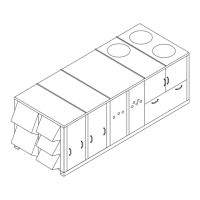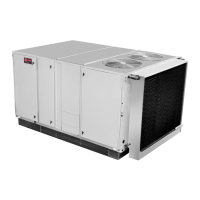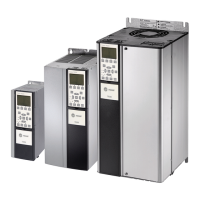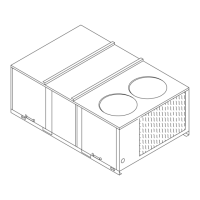108 RT-SVX34C-EN
Startup
Scroll Compressor Operational Noises
Because the scroll compressor is designed to accommodate liquids (both oil and refrigerant) and
solid particles without causing compressor damage, there are some characteristic sounds that
differentiate it from those typically associated with a reciprocating compressor. These sounds
(which are described below) are characteristic, and do not affect the operation or reliability of the
compressor.
At Shutdown
When a Scroll compressor shuts down, the gas within the scroll compressor expands and causes
momentary reverse rotation until the discharge check valve closes. This results in a “flutter” type
sound.
At Low Ambient Startup
When the compressor starts up under low ambient conditions, the initial flow rate of the
compressor is low due to the low condensing pressure. This causes a low differential across the
thermal expansion valve that limits its capacity. Under these conditions, it is not unusual to hear
the compressor rattle until the suction pressure climbs and the flow rate increases.
During Normal Operation
The scroll compressor emits a higher frequency tone (sound) than a reciprocating compressor.
Compressor Crankcase Heaters
Each compressor is equipped with a crankcase heater. When the compressor is "Off", the crankcase
heater is energized. When the compressor is "On", the crankcase heater is de-energized. The proper
operation of the crankcase heater is important to maintain an elevated compressor oil temperature
during the "Off" cycle which reduces the potential for refrigerant to migrate into the compressor oil.
Table 64. 41.7 Ton Dual Circuit—Operating Pressures (50 Hz)
TC, TE, YC* 500 Circuit #2
Full Load
1200
1700
2200
2700
3200
3700
4200
600 700 800 900 1000 110 0 12 00 1300
Suction Pressure (KPa)
Discharge Press ure (KPa )
20. 0/13. 9 C ID
12 .8 F OD Ambien t
29. 4 F OD Ambient
23.9 F OD Ambient
18.3 F OD Ambient
46 .1 F OD Ambien t
40.6 F OD Ambient
35.0 F OD Ambient
30.0/22.2 C ID
26.7/ 19.4 C ID
23.3 /16.7 C ID

